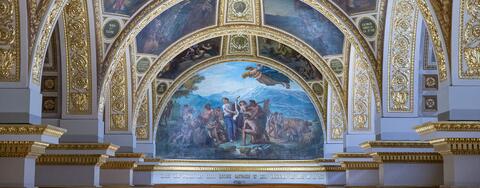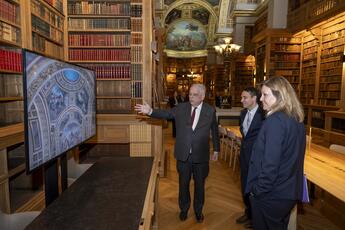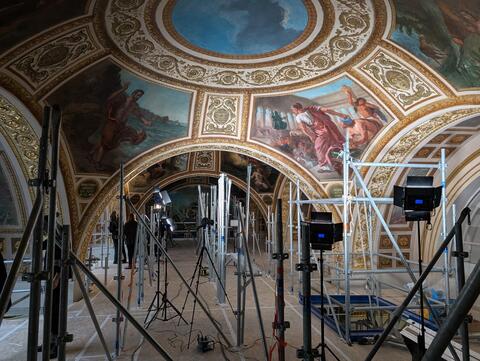
From paint to pixels: the Digital Delacroix project
At the French National Assembly, a restoration project has sparked a multidisciplinary scientific adventure centered around the work of Eugène Delacroix.

The project
Taking advantage of the library's restoration, art historian Barthélémy Jobert and his team launched the "Digital Delacroix" project: where 3D modeling, artificial intelligence, and art history converge to uncover the secrets of a landmark 19th-century decor. A highlight of this collaboration was the institutional partnership agreement signed on April 8, 2025, between Sorbonne University and the National Assembly, affirming their joint commitment to research and heritage promotion.
A Restoration Project in the Heart of the National Assembly
The National Assembly houses two decorative ensembles painted by Eugène Delacroix and his assistants. The first, restored thirty years ago, is in the Delacroix Room adjacent to the main chamber. But the library ceiling poses the greatest artistic and technical complexity. Stretching around 50 meters long and 20 meters wide, five domes—each divided into four sections and adorned with architectural and sculptural elements—are framed by two semi-domes, all rising about 20 meters above ground.

Orthophotographie du plafond de la bibliothèque de l'Assemblée nationale ©Nicolas Leys - SCAI
The Photographic Campaign
In the summer of 2023, the National Assembly decided to restore the library from floor to ceiling. Scaffolding was installed, providing a unique opportunity to conduct a photographic campaign of the ceiling—a long-envisioned research project led by Delacroix specialist Barthélémy Jobert.
"During various mural restoration projects I participated in, I had the privilege of observing Delacroix’s works up close. I had always hoped to one day offer the public a virtual tour that brings them as near as possible to these decorations. Quickly, the idea of a digital tour evolved into a deeper analytical project of Delacroix’s artworks. The challenge was to produce very high-quality images capturing both the material characteristics and spatial layout of the works," Jobert explains.
Thus, the library restoration and scaffolding became the catalyst for these dormant initiatives.

Chantier de restauration du plafond de la bibliothèque de l'Assemblée nationale ©Nicolas Leys - SCAI
Unprecedented Scientific Documentation on Delacroix
"During the restoration, the National Assembly was incredibly cooperative," notes Jobert. "We were able to conduct three phases of photography—before, during, and after the restoration—thanks to the invaluable help of a visual studies engineer from SCAI who captured all the imagery."

"La Drachme du Tribut" après nettoyage et après restauration ©Nicolas Leys - SCAI
A Digital Model
From over 10,000 images taken during the campaign, scientific visualization engineer Nicolas Leys produced a digital model enabling virtual exploration of the space. "The quality is such that restorers, by zooming in, could spot details invisible to the naked eye. We now have an exceptional documentary base that allows us to pursue the research paths long envisioned around Delacroix."
Photogrammétrie du plafond de la bibliothèque de l’Assemblée nationale ©Nicolas Leys - SCAI
Four Pillars of an Ambitious Program
The Digital Delacroix project is now structured around four key areas. The first pillar focuses on creating a high-fidelity virtual tour allowing users to navigate the decor via a web interface. "We want full immersion, where users can choose their own path and zoom in on fine details, even the surface textures. This presents technical challenges—handling vast amounts of data while ensuring accessible load times," says Jobert.
The second axis involves scientific analysis of the ceiling’s decor using artificial intelligence. "We believe it’s possible—though still experimental—to analyze the entire decor to identify which sections were painted by Delacroix and which by his assistants. The goal is to train an AI to distinguish between these artistic hands," Jobert summarizes.
The team benefits from two major resources: high-quality data collected during the library restoration, and a partnership with the C2RMF (Research and Restoration Center for French Museums), which will provide photographic documentation of Delacroix’s works. "This will enrich our training data set and improve the chances of identifying unique pictorial signatures belonging to Delacroix," Jobert adds.
The third pillar—initiated several years ago—centers on Delacroix’s correspondence. "The evolution of digital humanities over the last fifteen years has changed our approach," says Jobert. What began as a simple digitization effort is now a foundation for deeper intellectual analysis, including text mining to explore ideas, concepts, links with 19th-century art criticism, and comparisons with Delacroix’s contemporary texts.
The fourth and once-hypothetical pillar is now within reach: using generative AI to reconstruct the decor of the Salon de la Paix at Paris’s Hôtel de Ville, destroyed in the 1871 fire. Only sketches, preparatory drawings, a few student-made copies, and two old photographs survive. Added to this are period plans, measurements, and documentation on a second salon painted by Ingres.
"With these materials and help from video game specialists, we can virtually rebuild the location’s architecture," hopes Jobert. Generative AI, trained on interpretive data and Delacroix’s preparatory work, could then generate a credible reconstruction of the lost frescoes. "Even with the best data, AI doesn’t give us absolute truth—it offers probabilities. It’s up to us, the art historians and scientists, to interpret those results," Jobert reminds us.
A multidisciplinary effort
The project has advanced thanks to the commitment and collaboration of several teams from Sorbonne University, drawing on the expertise of its various faculties. The Centre André-Chastel has provided leadership on the art historical aspects of the initiative, particularly in contextualizing Delacroix’s work within 19th-century artistic traditions. The Plemo 3D platform—already experienced in digitally scanning heritage sites—previously captured the architecture of the library and the Delacroix Room at the National Assembly, as well as Delacroix’s monumental religious murals in Parisian churches such as Saint-Sulpice and Saint-Denys du Saint-Sacrement. The SCAI platform played a pivotal role in both the photographic campaign and the application of artificial intelligence. Their work made it possible to gather the tens of thousands of high-resolution images required for 3D modeling and stylistic analysis. Complementing this, the ObTIC platform has been instrumental in the digital humanities strand of the project, analyzing Delacroix’s correspondence using text-mining tools to uncover intellectual patterns, thematic recurrences, and connections to 19th-century art criticism.
Another major contributor is the Laboratory of Molecular and Structural Archaeology (LAMS), which specializes in the chemical analysis of art materials. This laboratory has supported efforts to differentiate the contributions of Delacroix from those of his assistants. Using non-invasive optical technologies, LAMS was able to collect data on pigments and materials used in different parts of the mural. Although these analyses were limited to select areas, the results provide invaluable insight and complement the extensive photographic documentation provided by the Centre de recherche et de restauration des musées de France (C2RMF). “LAMS mobilized a team that performed precise, non-invasive optical studies,” says Barthélémy Jobert, “and while the scope was geographically limited, the information will significantly enrich our comparative research.”
Though over three-quarters of the project has been carried out with internal Sorbonne University resources, progress accelerated in March 2025 thanks to support from the Schmidt Foundation, which funds projects at the intersection of AI and heritage. "We received funding to hire a scientific visualization engineer and allocate work hours for a data scientist to identify the authors of different decor parts." The foundation’s backing also allows the recruitment of a postdoctoral AI researcher, scientific visualization interns, and an art history postdoc who will work on image calibration from the C2RMF and on textual corpus analysis.
Additional funding may come from Sorbonne University’s “Pre-maturation” project call, aimed at recruiting video game design interns and a cultural mediation engineer to develop the first scripted version of the virtual tour. This immersive experience is expected to be made accessible to the public within six months to a year, both on the National Assembly’s website and on that of Sorbonne University.
Project outlook
"With these funds, we can now move forward on all four fronts at a much faster pace," announces Jobert. With a start set for September, researchers hope to draw conclusions within a year on the project’s two most experimental pillars: the digital reconstruction of the Salon de la Paix and the AI-based analysis of the artistic “hands” behind the library decor.
Jobert also envisions expanding the project: "In the short term, we could respond to new project calls to study other already restored Delacroix decorations—or even anticipate future restoration work, like that of the Senate library." In the longer term, the team may widen the scope of research to other major 19th-century French mural paintings beyond Delacroix, or even explore large-scale painting traditions from that period more broadly.
